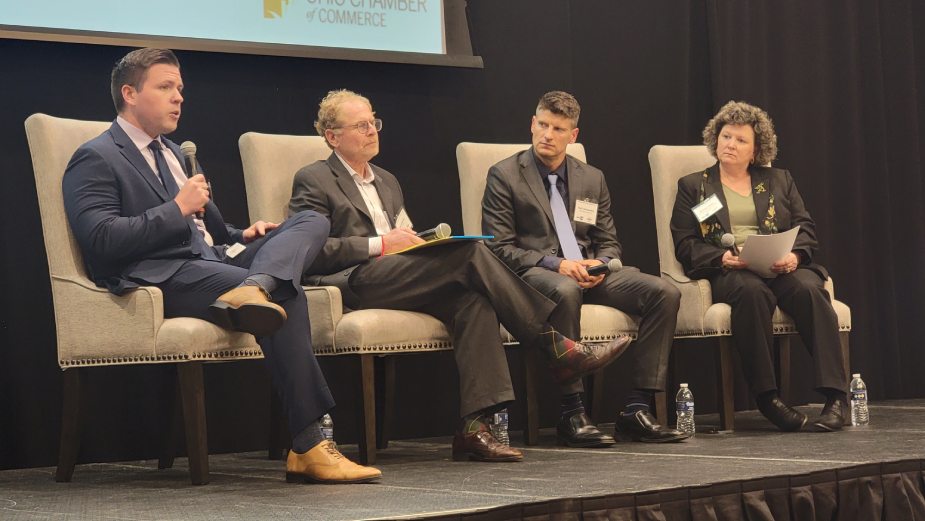Next Phase Celebrated in Lake-to-River Broadband Project
YOUNGSTOWN, Ohio – Buoyed by $500,000 in funding from the Ohio Department of Development and BroadbandOhio, the Eastgate Regional Council of Governments announced Wednesday the start of the engineering phase for the Lake-to-River Fiber Line project along the state Route 11 corridor.
Designed to serve 620,000 residents with connectivity, the project was the recommendation of a feasibility study that included Mahoning, Trumbull and Ashtabula counties. Columbiana County was then added to the project due to a common goal of bringing broadband access the length of state Route 11 and reaching the Ohio River.
The broadband feasibility study began in the summer of 2020. Mark Ragozine, economic development project manager, pointed out the pandemic really emphasized the gaps in the broadband internet.
The project not only will provide better connectivity for residents and individual consumers, but also businesses, as well as community anchor institutions such as schools, libraries, government offices, government services, community colleges and universities.
“So it’s really an all encompassing opportunity,” says Ragozine.
The $500,000 engineering analysis is ready to begin and should be shovel-ready when the funding becomes available to complete the fiber optic line along nearly 100 miles of state Route 11 right-of-way. The middle mile line could be connected with additional fiber lines along Interstate 90 and the Ohio Turnpike.
An application for funding is in the works for the needed $15 million through the Middle Mile Plan with the National Telecommunications and Information Administration, part of larger $130 million package being sought.
Should the funding be obtained in the spring, Ragozine said the project would begin in May or June of 2023 with a projected completion of two- to three years. The funding would require completion within five years.
The middle mile portion, considered the “backbone,” would then lead to the last mile, where additional lines would be connected to reach more rural areas.
“This is a first of a kind initiative where we’re placing conduit fiber in the state right-of-way. So we certainly appreciate all the assistance we have had from the Department of Transportation,” said Jim Kinnick, executive director of Eastgate.
“Fiber placement will not only benefit the residents of Ashtabula, Trumbull, Mahoning and Columbiana counties, but also impacts businesses, community anchors, government and educational institutions,” he said. “With higher speed internet, they will spur economic development and catalyze innovation.”
Eastgate’s goals include an engineering plan that will create a technical blueprint for the completion of this project, which will bring new internet service providers, telecommunication carriers and data center services to the region. Kinnick says this will lead to other investments in the four counties.
Lydia Mihalik, director of the Ohio Department of Development, said the DeWine-Husted administration has made expanding broadband a priority.
“Without reliable internet, Ohioans face a significant barrier in accomplishing everyday activities, such as working remotely, staying connected to friends and family, accessing online learning and even seeing a doctor,” Mihalik said.
State support fthrough BroadbandOhio for the Lake-to-River project is in addition to earlier BroadbandOhio efforts, which have provided $232 million to 11 internet providers and assistance with several other projects, according to Mihalik.
State Sen. Michael Rulli, R-33, said he was recently driving from Carroll County toward Columbus and found he had no phone connection to assist with his navigation. With so many things going on, Rulli said there are still problems. Children in inner cities and rural Ohio were all told to stay home from school, but they could not learn without broadband.
“How are we going to be a cutting-edge state and the corridor for the renaissance we are creating if we don’t have broadband,” Rulli said.
J.P. Ducro, Ashtabula County commissioner; Frank Fuda, Trumbull commissioner; Carol Rimedio-Righetti, Mahoning commissioner; Youngstown Mayor Jamael Tito Brown; and Penny Traina, executive director of the Columbiana County Port Authority, were among those on hand to talk about the process of getting the project underway.
“The study showed the two largest cities in Trumbull County are the top 20 least connected cities in the state of Ohio …” Fuda said. “Much of northern Trumbull County was identified as unserved and underserved and they are so appreciative.”
Brown spoke about the importance of connectivity to the elderly, like his mother and her sisters who were separated physically by the pandemic, but were able to still reach out through Zoom and Facebook.
“What about the mothers and aunties that are out there, who could not connect with their family during the pandemic?” Brown said.
Traina emphasized the cost of this project is too much for any of the individual counties, but by working together and partnering with Broadband Ohio and the state, it becomes possible to help residents and businesses grow, expand and remain in the area.
Many of the elected officials also talked about the importance of collaborating with partners and working together, not as Democrats and Republicans, in order for this area to grow and be successful.
Pictured at top: State Sen. Michael Rulli, R-33; Ashtabula County Commissioner J.P. Ducro; Lydia Mihalik, director of the Ohio Department of Development; Jim Kinnick, executive director of Eastgate; Youngstown Mayor Jamael Tito Brown.
Copyright 2024 The Business Journal, Youngstown, Ohio.



